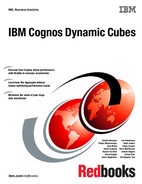
Chapter 8. Optimization and performance tuning 203
performance because the aggregated data is stored in memory in the aggregate cache of the
dynamic cube.
For warehouses that do not yet have aggregates, or want to supplement existing database
aggregates with in-memory and other in-database aggregates, run the Aggregate Advisor as
part of an optimization workflow to get recommendations for aggregates, both in-memory and
in-database.
8.3 Overview of the Aggregate Advisor
The Aggregate Advisor offers aggregate recommendations that provide coverage for OLAP
queries against Cognos Dynamic Cubes based on cube model analysis and, optionally, a
query workload. Before running the Aggregate Advisor, the expectation is that the dynamic
cube is published in the Content Store, can be started successfully, and that reports and
analysis run and return correct results.
8.3.1 Model-based analysis
At the core of the Aggregate Advisor logic is its theoretical, model-based evaluation. The
Aggregate Advisor evaluates the cube model and experiments with potential slices of the
cube, and evaluates these candidates on various heuristics. Some examples of heuristics
include the balance between coverage in relation to other candidates so that aggregates can
be logically derived from one another and number of manageable aggregates, and selectivity
based on effective size relative to the underlying fact data.
8.3.2 Workload-based analysis
The aggregate recommendations can be much more relevant to actual user queries if
information from a representative query workload is captured. If workload logging is enabled
for the cube, any report that is run, drill behavior, and any user action in the Cognos studios
that results in a query that is processed by the Cognos Dynamic Cubes engine will be logged
in a separate workload log.
Running the Aggregate Advisor to consider workload information in the workload log will
significantly weigh the measures and slices that are actually hit by users so that the
aggregate recommendations are likely to be more reflective of query usage of the data.
Note: The easiest way to get aggregates that will significantly improve query performance
is to run the Aggregate Advisor. The Aggregate Advisor provides in-memory aggregates
for the aggregate cache, and recommendations for database aggregates.
Note: The Aggregate Advisor can be run without having any workload information. To get
better, more relevant aggregate recommendations, a representative workload should be
captured and used by the Aggregate Advisor.
..................Content has been hidden....................
You can't read the all page of ebook, please click here login for view all page.
